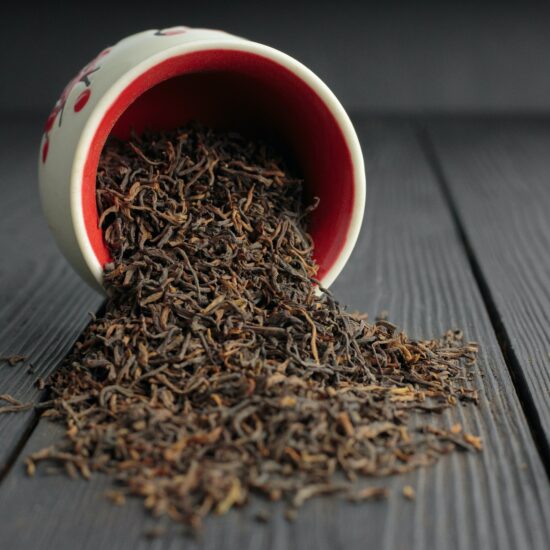
We continue our in-depth exploration of tea by looking at oolong, black, fermented, and herbal tea.
BY EMILY MENESES
SENIOR ONLINE CONTRIBUTOR
Cover photo by Drew Jemmett via Unsplash
Several weeks ago, we released part one of the ”A Beginner’s Guide to Tea” series, where we explored where tea comes from and two of the main types of tea: white and green. Today, we’re continuing our discussion by delving into the other main types of tea: oolong, black, fermented, and herbal.

Oolong Tea
Oolong is a partially oxidized or semi-oxidized tea, which means that enzymes in the tea leaves are allowed to interact with oxygen, darkening the tea leaves and producing a stronger, earthier flavor. Grown mainly in China and Taiwan, the tea leaves for oolong are harvested in late spring and early summer. The leaves are then gently bruised, releasing the enzymes, and spread out in direct sunlight to dry. During the drying process, farmers will turn the leaves regularly to ensure that they’re evenly oxidized. After drying out in the sun, the leaves are pan-fired, bringing oxidation to a halt.
Oolong tea ranges in color from light yellow to dark amber, with flavors ranging from light, sweet, and floral to strong, smoky, and earthy. Light oolong teas have an airy body, while darker oolong teas have a thick mouthfeel.
Brewing Oolong Tea
To brew a 6-8-ounce cup of oolong tea, use about 1 teaspoon of tea leaves and water heated to about 175-200 degrees Fahrenheit. Steep the tea leaves for up to 5 minutes, depending on how strong you prefer your tea.

Black Tea
Out of all of the main types of tea, black tea requires some of the most extensive production. After harvesting, tea leaves are withered in direct sunlight, then processed using either the CTC method (crush, tear, curl) or the orthodox method. With the CTC method, tea leaves are fed through machines that crush, tear, and curl them, resulting in small brown pellets. Because the CTC method typically uses lower-quality leaves, it’s a common choice when producing tea bags.
High-quality black teas are typically produced using the orthodox method, which is more time-consuming and requires more human labor. In orthodox processing, tea leaves are produced in the traditional way—with plucking, withering, rolling, oxidation, and drying. This process can be done with machines or by hand and is carefully overseen by trained tea professionals to ensure that the best flavors are extracted from the leaves.
In terms of flavor, black tea is bold and earthy, sometimes showcasing floral or nutty undertones and a savory, “umami” quality with subtle hints of sweetness.
Brewing Black Tea
More delicate teas are best brewed with water that’s slightly below boiling point. Black tea, however, is best brewed with boiling water—the high temperatures draw out the strong flavors it’s known for. When brewing black tea, use about 1 teaspoon of tea leaves for every 6-8 ounces of water, and steep your tea for about 3-5 minutes.

Photo by Petr Sidorov via Unsplash.
Fermented Tea
Fermented tea is made from aged tea leaves, and the most common form of fermented tea is pu-erh. While other teas undergo oxidation, fermented teas undergo fermentation (a process also used when making beer, yogurt, and kombucha). During fermentation, the tea leaves break down and decompose.
To produce fermented tea, tea leaves are harvested then dry-roasted, lightly bruised through rolling and rubbing, and dried in the sun. To begin the fermentation process, the tea leaves are then placed in a humid environment for months or even years. Some teas are aged over decades and go for up to thousands of dollars a pound. Depending on how long the tea was aged for, fermented tea shows great depth and complexity in flavor. Fermented tea is typically woodsy and earthy with a full body.
Brewing Fermented Tea
Traditionally, fermented tea leaves are rinsed with hot water before brewing. For every 8 ounces of water, use about 1 teaspoon of tea leaves and water heated to about 195 degrees Fahrenheit. Brew your tea for 2-4 minutes.

Pictured: Constellation Coffee’s ginger guava tea. Photo courtesy of Kevin Kim.
Herbal Tea
No tea guide would be complete without including herbal tea. “Herbal tea” refers to any water-based infusion made from plants that are not the Camellia sinensis plant. Another common name for herbal tea is “tisane.“ Popular herbal teas are made from flowers like lavender or chamomile, herbs like peppermint or calendula, and spices like cinnamon or cinnamon. Herbal teas tend to be caffeine-free, and each one offers unique flavors and healing benefits.
Brewing Herbal Tea
When brewing herbal tea, about 1 teaspoon of herbs/flowers should be used for every 6-8 ounces of water. Water temperature and steeping time will vary depending on the type of herbs used, but most should be steeped for at least 5 minutes. Do some research to find the best brewing methods for the particular tisane you’re drinking.
ABOUT THE AUTHOR
Based in Los Angeles, Emily Joy Meneses (she/her) is a writer and musician passionate about culture and collective care. You can regularly find her at Echo Park Lake, drinking a cortado and journaling about astrology, art, Animal Crossing, and her dreams. Explore her poetry, short stories, and soundscapes on her website.




